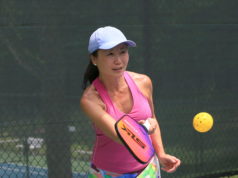By Dr. Neeru Jayanthi
Does your ALTA team ever struggle to field a full team because of injuries? Over the last 30 years as a competitive player, I have had my share of injuries, but as a sports medicine and tennis medicine physician, I have treated many more tennis injuries and re-injuries. I have since made a commitment to research and develop strategies to prevent injury and re-injury in junior and adult tennis players, including myself. We previously published research on more than 500 junior elite players for a summer tennis season and found that those who reported a prior injury were five times more likely to medically withdraw from a tournament. In another study of more than 500 adult recreational league players, we noted that nearly 50 percent reported an injury where they missed at least one week in the last year.
Here are some strategies that can help reduce personal risk of re-injury — and keep your ALTA team roster full.
How Much is Too Much?
Identify your own risk: Every player has a different level of risk for injury (and re-injury), which is different for junior and adult players. High-risk players are more likely to have a more difficult problem to treat and should be seen earlier to identify/treat problems immediately. For example, a highly ranked 13-year-old junior tournament player with low back pain has a nearly 50 percent chance of having a low back stress fracture.
Risk factors for high-risk players who may need earlier medical evaluation based on Emory Sports Medicine Center research:
JUNIORS
• Prior injury (back, shoulder, elbow, wrist)
• Specialized
• High weekly volume of tennis (more than 10-16 hours)
• High amount of competition (40-plus matches per year or more than 12 tournaments per year)
• Higher level
• Rapid growth
• Older, male
• More than four matches in a tournament
• High-risk technique/strokes
• No dynamic warm-up
• No injury prevention techniques
ADULTS
• Prior injury (elbow, shoulder, back, knee)
• 10 or more hours per week of play
• Advanced level (NTRP 4.5+)
• More than six weeks of symptoms
• 40 years old and greater
• Regular competition
• Prior surgery
• No dynamic warm-up
• No injury prevention techniques
• Poor technique
Identify the high-risk areas that should not be ignored
After you determine your overall risk, you should decide if your pain or injury is in a high-risk area. If it is in a high-risk area, these are typically more likely to result in long-term problems, re-injury and time away from the sport, unless you can treat the pain or injury early. High-risk locations include:
JUNIORS
• Low back
• Shoulder
• Elbow
• Wrist
• Hip
ADULTS
• (Tennis) Elbow
• Low back
• Shoulder (rotator cuff)
• Knee
• Foot/ankle (tendons)
Early Recognition Means Early Treatment
For most overuse injuries in junior and adult players, identification of an injury early in the process is much more likely to be treatable with full recovery than those in the later stage. For example, a young player with a low-back stress fracture may have healing rates from 0 to nearly 100 percent, and it may take three to five months to treat based on when treatment is begun. Similarly, adults who have late-stage tendon problems may have difficulty returning to tennis after many months, or they may even rupture their tendon if they wait too long to get treated!
Injury-specific stroke changes: Yes, poor stroke mechanics can also play a role in recurring injuries. I recently published an article on a number of injured players I instructed on some simple on-court stroke accommodations to return more than 90 percent of them safely to tennis in under six months. Juniors, for example, should limit low-back extensions on the serve to less than 20 degrees (Figure 1a) and adults with tennis elbow or rotator cuff impingement in the shoulder should use lower body hip/pelvis on all strokes and avoid early and excess forearm rotation on groundstrokes (Figure 1b). Since only a few medical professionals can make these on-court changes, these stroke accommodations may also be coordinated with a tennis teaching professional with knowledge on tennis strokes and injury risk.
Treat the Problem, Not the Pain
How many times have you talked to a teammate on your ALTA team who went somewhere for a quick fix of the pain, but then had the same injury again? Unfortunately, only treating the pain may not help treat the underlying problem, and often, the problem comes back. For example, just taking medicines, doing cortisone injections or “taking time off” often does not address rehabilitation deficits, risky stroke mechanics or true treatment of later-stage problems (i.e., improving the health of the injured tendons or joints using injection procedures without steroid).
Atlanta and ALTA have some of the best tennis opportunities in the country. Make sure to follow these simple rules to prevent re-injury and make sure you don’t keep missing out on great tennis… again!
_______
Jayanthi is the president of the Society for Tennis Medicine and Science, an associate professor in orthopaedics and family medicine at Emory University and director of tennis medicine at the Emory Sports Medicine Center. For more information, visit emoryhealthcare.org/tennismedicine or call 404.778.1831.




